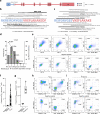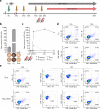The oncogenic fusion protein DNAJB1-PRKACA can be specifically targeted by peptide-based immunotherapy in fibrolamellar hepatocellular carcinoma
- PMID: 36302754
- PMCID: PMC9613889
- DOI: 10.1038/s41467-022-33746-3
The oncogenic fusion protein DNAJB1-PRKACA can be specifically targeted by peptide-based immunotherapy in fibrolamellar hepatocellular carcinoma
Abstract
The DNAJB1-PRKACA fusion transcript is the oncogenic driver in fibrolamellar hepatocellular carcinoma, a lethal disease lacking specific therapies. This study reports on the identification, characterization, and immunotherapeutic application of HLA-presented neoantigens specific for the DNAJB1-PRKACA fusion transcript in fibrolamellar hepatocellular carcinoma. DNAJB1-PRKACA-derived HLA class I and HLA class II ligands induce multifunctional cytotoxic CD8+ and T-helper 1 CD4+ T cells, and their cellular processing and presentation in DNAJB1-PRKACA expressing tumor cells is demonstrated by mass spectrometry-based immunopeptidome analysis. Single-cell RNA sequencing further identifies multiple T cell receptors from DNAJB1-PRKACA-specific T cells. Vaccination of a fibrolamellar hepatocellular carcinoma patient, suffering from recurrent short interval disease relapses, with DNAJB1-PRKACA-derived peptides under continued Poly (ADP-ribose) polymerase inhibitor therapy induces multifunctional CD4+ T cells, with an activated T-helper 1 phenotype and high T cell receptor clonality. Vaccine-induced DNAJB1-PRKACA-specific T cell responses persist over time and, in contrast to various previous treatments, are accompanied by durable relapse free survival of the patient for more than 21 months post vaccination. Our preclinical and clinical findings identify the DNAJB1-PRKACA protein as source for immunogenic neoepitopes and corresponding T cell receptors and provide efficacy in a single-patient study of T cell-based immunotherapy specifically targeting this oncogenic fusion.
© 2022. The Author(s).
Conflict of interest statement
J.B., N.K., Y.M., M.Z., S.D., M. Boerries, and J.S.W. are listed as inventors on a patent related to the DNAJB1-PRKACA T cell epitopes and TCRs (Peptides and antigen binding proteins for use in immunotherapy against fibrolamellar HCC and other cancers, Application number: EP21214728.4). H.-G.R. is listed as an inventor on a patent related to the adjuvant XS15 (Adjuvant for the induction of a cellular immune response: DE102016005550.2). The other authors declare no competing interests.
Figures





References
-
- Stackelberg AV, et al. A phase 1/2 study of blinatumomab in pediatric patients with relapsed/refractory B-cell precursor acute lymphoblastic leukemia. Blood. 2013;122:70–70.
Publication types
MeSH terms
Substances
Supplementary concepts
LinkOut - more resources
Full Text Sources
Medical
Molecular Biology Databases
Research Materials
Miscellaneous

